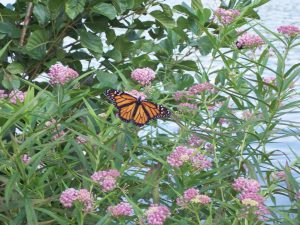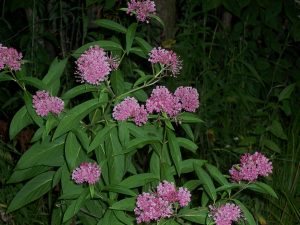1 Swamp Milkweed likes wet soils
With a record amount of rainfall this summer, Swamp Milkweed caught my attention because this versatile plant likes wetter soils and even clay soils.
- Looking for an outstanding and showy flower to plant that grows in wet soils and supports important pollinators? Swamp Milkweed is a super hero of plants. To grow Swamp Milkweed, Asclepias incarnata, start with a walk around the whole area.
- Take a closer look at your landscape’s characteristics. Kneel or crouch down, say about a foot or two feet from the ground and look across the horizon at all the high and low places in your garden from several different angles. Do you see lower damp areas called swales, springs or moist areas near creeks and add irrigation ditches and moist areas where grass grows faster? Where are the “wet feet” areas for growing plants?
- Identifying wet soils: the plants that like “wet feet” are able to grow and tolerate the more water-filled soils. Dig about six inches to one foot and check the soil moisture levels. Does your soil stay saturated or wet most of the season? Does it naturally pond after a rainfall? You can see and feel the ground over several days for a general impression. Swamp Milkweed likes wet roots and grows throughout the Unites States in wet soils. Swamp Milkweed is found naturally along creeks, lakes and water edges. Plant near the edge of the water, but not in the water.

Monarch Butterfly enjoying Swamp Milkweed. Photo, Betsy Nottingham
2 Swamp Milkweed tolerates clay soils
- According to the USDA fact sheet Asclepias incarnata, Swamp Milkweed tolerates heavy clay soils. Dense, heavy clay soils are a common challenge in gardens and frequently found in low-lying areas.
3 Swamp Milkweed is deer-resistant
- The alkaloid content in milkweeds is bitter. Deer find it repugnant and avoid eating milkweeds.
4 Swamp Milkweed is found throughout the continental United States
USDA MAP of Swamp Milkweed in green.
- As a native perennial, Swamp Milkweed grows in most states, except in some Western states.
- It is an important plant recommended for land use in wetland restoration and conservation.
- Native plants support native pollinators and integrate beautifully into the ecosystem.
5 Swamp Milkweed is the favorite food of Monarch Butterflies
- The Monarch Butterfly loves the nectar of Swamp Milkweed flowers throughout the bloom season. The leaves also serve to feed young Monarch caterpillars.
- Monarchs are a species at risk from loss of habitat and need patches of milkweed.

Monarch caterpillar and Swamp Milkweed, late summer. Photo Will Zacker
6 Swamp Milkweed is a perennial plant
Native milkweed is a perennial, which means it is a plant that returns and grows the next year where it was planted. Pollinators rely on dependable feeding habitats year after year. In fact, pollinators even return to the same flowers, coming back several hours on the same day to check the nectar and pollen levels. It takes a long time to regenerate depleted nectar in plants. As a beneficial plant, Swamp Milkweed buds continue to open at different times on the same plant to offer nectar and pollen.
- Specialized Honey Bees called Scouts spend a lot of time in the air. Bees may travel from five to forty miles a day. When you grow mass plantings of Milkweeds, bees can easily see Swamp Milkweed from some distance away.
7 Swamp Milkweed is a good vegetative cover for stormwater basins
- Swamp Milkweed is valuable in stormwater management for water flow and drainage in basins. Where the soil stays damp or slightly wet, grow Swamp Milkweed on the lower and middle sides of the slopes.
- Uplands plants tolerate drier soils and more drought-resistant species. Compliment your Swamp Milkweed with Black Eyed Susans, Purple Coneflower, Poppies and Asters, which do well in the top area of a stormwater basin that is sunny and drier.
- A vegetative cover of Swamp Milkweed prevents soil erosion. Deep-rooting, perennial plants help slow down the flow of fast-moving water during storm runoff.
8 Swamp Milkweed and mud puddling for butterflies
- As a landscaping plant, Grow Swamp Milkweed looks great next to water features in gardens and attracts butterflies to your garden.
- An open, flat mud puddle near the milkweed attracts Butterflies for “mud puddling.” Butterflies like to gather in mud puddles to drink and sip salts from mineral nutrients in soil.
9 Swamp Milkweed and the Monarch Migration Route
Add Blake’s Five Monarchs on a Swamp Milkweed photo
- Habitat loss is responsible for part of the decline in Monarch Butterflies.
- Monarch Butterflies follow a known established migratory route which presents challenges to find feeding sites and pollinator gardens along the Route.
- Monarchs will visit your Swamp Milkweed to lay eggs and reproduce on their way north. On the return trip, they can sip nectar from late-blooming flowers in your garden.
10 Swamp Milkweed in naturalizing gardens is a visual beauty
- Swamp Milkweed, Asclepias incarnata, is a rosy, muted to deep pink. It has a restful, natural presence in gardens.
- In color theory, red and green are complements. A shade of pink balances with green; it is a warm color beside the fresh, cool feeling green.
- Swamp Milkweed naturalizes, creating large broad waves of color. Naturalized patches follow patterns in nature, not artificially straight lines.
- To get a butterfly’s attention, consider plant large groupings of three to five plants in different spots, and near water features in your gardens.

Swamp Milkweed is a longlasting, bright pink flower for summer and late season pollinators Photo Betsy Nottingham
References
United States Department of Agriculture, USDA Swamp Milkweed
USDA map of Swamp Milkweed in continental United States
Morgridge Institute for Research, Blue Sky Science: “Do plants produce nectar every day?”
Philadelphia Water Department Stormwater Management Practice Guidance
www.texaspollinatorpowwow.org
US Department of Agriculture Forest Service Monarch Butterfly Migratory Route
The National Wildlife Federation Garden for Wildlife Swamp Milkweed
Colormatters.com






Very interesting article on Milkweed and Butterflies.
I like seeing lots of butterflies in my garden but they
are very scarce. So are the bees. It is good to see
that some plants are deer resistant. We have a
deer problem in our neighborhood.